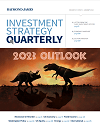by Larry Adam, CIO, Raymond James
View the full article and additional 2020 financial insights in the Investment Strategy Quarterly publication linked below.
As 2020 begins, investors seek clarity and foresight, especially given the daily dose of unprecedented headlines. We hope the ten themes below provide a sharp, reliable lens to help bring your portfolio decisions into focus.
1. Keeping a close eye on the economy
We forecast that U.S. GDP growth will be moderate at 1.7%, but that the current record-setting economic expansion will continue at least through the presidential election. A resilient labor market, robust consumer spending and a rebound in global growth should be supportive. Although recessions rarely begin in election years, multiple dynamics will cause us to sharpen our pencils when assessing the economy post-election. Our real-time economic indicators suggest a small probability of a recession in 2020, and keeping a close eye on them will be crucial should the economy meaningfully weaken.
2. The Fed’s “corrective surgery”
When the U.S. economic outlook was clouded by trade tensions and slowing global growth, the Federal Reserve (Fed) performed corrective surgery in the form of three “insurance” rate cuts, which recalibrated Fed policy and extended the duration of the current expansion. Knowing that the impact of monetary policy lags and that the Fed has limited ammunition with the fed funds target rate at 1.50-1.75%, we do not anticipate interest rates will be altered in 2020.
3. Tunnel vision on the U.S. presidential election
While Congressional gridlock (Republican Senate, Democratic House) continues to be the likely outcome, uncertainty remains at the top of the ticket. The determination of the Democratic candidate may last well into the summer with an increasing probability of a “brokered convention” – the first for the Democratic Party since 1952 – the longer the process lasts. Historically, positive economic data has led to a favorable outcome for the incumbent. But given the level of division across the country, the election may be determined by two key swing states: Pennsylvania and Wisconsin.
4. A magnified look at the bond market
Global yields and spreads remain near record lows and continue to reduce the upside return for the bond market overall. Due to more moderate U.S. growth, muted inflation, international demand and favorable demographics, we don’t expect the 10-year Treasury yield to move significantly this year (year-end target: 1.75%). While credit market spreads will widen slightly, we don’t expect this will negate the positive performance of investment grade and emerging market bonds.
5. See the bigger picture for U.S. equities
The macroeconomic backdrop remains supportive with muted risk of a recession, lower interest rates and easing financial conditions. 2019 performance was largely driven by P/E expansion, but 2020 should renew the emphasis on earnings growth, which we forecast at 5%-6%. Election years have been historically positive for the equity market, and our base case is that the S&P 500 notches new highs and rallies to ~3,350 by year end.
6. Double vision of favorite sectors
We still favor cyclicals over defensives, with four of our five favorite sectors being Information Technology, Communication Services, Financials, and Industrials. Our lone defensive choice is Healthcare, which lagged in 2019 due to political risk. This sector selection has us seeing double, as a bias towards these sectors is inherently beneficial to small-cap stocks. From both a market capitalization and revenue perspective, small cap carries its highest exposures and weightings towards these same sectors.
7. Near and far sights for Technology sector
We envision Technology being a standout again this year. Our near sights are focused on earnings visibility, which remains strong with the anticipated rollout of 5G. The transition from 4G to 5G is the largest enhancement in wireless technology in a decade, and we believe this will be a multi-year catalyst for everything from semiconductors to phone carriers. The benefits should permeate across other industries, keeping demand for new technologies, applications, services and software resilient.
8. Blurred vision for international equities
Preferring U.S. equities over international equities was relatively easy in recent years, but the line between the two now begins to blur. A possible bottoming in Europe’s economic data, attractive valuations on a relative basis, an acceleration in earnings growth and the possibility of substantial fiscal stimulus packages (especially in Germany) have the potential to propel international equities moving forward. We maintain our view on emerging markets as an appealing allocation for long-term investors.
9. A panoramic view of the dollar and oil
After rallying six times in the last seven years, a further broad-based rally in the U.S. dollar is unlikely. A Fed on hold, decelerating U.S. economic growth and burgeoning twin deficits will likely keep a stronger dollar out of view. A stable, slightly weaker dollar is a positive for commodities. We believe that oil prices will recover to six-year highs by the end of 2020 and rally to $65/barrel, supported by our expectation that global oil demand will grow slightly faster this year. The slow upward movement in oil prices has exerted pressure on the capital budgets of U.S. oil and gas companies, which should translate into a sharp slowdown in U.S. oil production.
10. Volatility is hiding in plain sight
As 2019 was the best year for U.S. equities since 2013 and aggregate bonds since 2002, investor complacency is evident. However, with relatively more expensive markets versus last year, volatility is hiding in plain sight. From growth concerns to geopolitical tensions, there’s no shortage of headline risk for 2020. Increased volatility and the aging bull market make selectivity at the regional, sector, and individual stock level even more important.
We always encourage investors to follow a well-thought out financial plan that tailors an appropriate asset allocation in light of specific investment objectives and risk tolerance. Your advisor can provide further clarity for your unique situation.

Read the full January 2020
Investment Strategy Quarterly
All expressions of opinion reflect the judgment of Raymond James & Associates, Inc., and are subject to change. Past performance may not be indicative of future results. Investing in international securities involves additional risks such as currency fluctuations, differing financial accounting standards, and possible political and economic instability. These risks are greater in emerging markets. Companies engaged in businesses related to a specific sector are subject to fierce competition and their products and services may be subject to rapid obsolescence.













